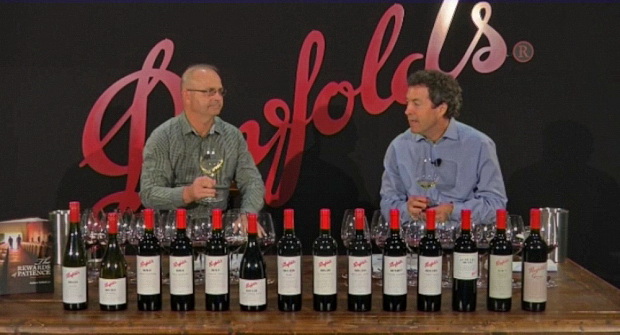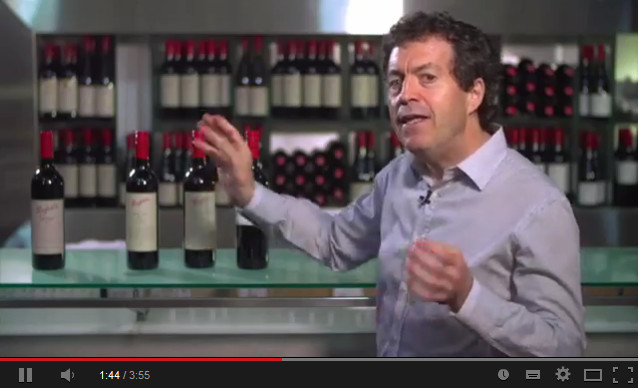Forget samples you can assess at your leisure
Gary Walsh from the Winefront recently made the point that Penfolds no longer sent him samples of these wines. Instead you could only taste them on Penfolds’ terms, either over a fancy dinner at Magill Estate, or by invitation at one of their big city release events. Wine writer Andrew Graham went to the one in Sydney, and then wrote about embargogate after he was told by Penfolds’ PR people to pull his tasting notes off his blog until February 28.
Andrew tells us that no one said anything about an embargo at the release event, which was for wine writers and journos. Perhaps Andrew didn’t quite see the big picture. The Manifesto reported that, on February 25 in far-away Hong Kong, Peter Gago and Steve Linert hosted the same event at the Mandarin Oriental in Hong Kong. This was a virtual event that went live across Hong Kong, Shanghai, Taipei, Singapore, and Khon Kaen, Thailand.
Upon entering,’ The Manifesto reports, ‘guests were greeted with rows of white-clothed tables, where the 14 vintage wines on offer were neatly arranged. Once seated, Penfolds Chief Winemaker Peter Gago appeared on the screen with the same assortment of wines that ranged from a 2009 Grange to a 2010 St Henri Shiraz. For the next two hours, guests were taken through the collection at the same time as wine tasters in the other Asian cities. It made for an intimate experience, done on a large scale.’
At the same time, PR Newswire reported that ‘Ruth’s Chris Steak House Partners with Penfolds for Exclusive Global Launch of Penfolds Bin 9 Cabernet Sauvignon on March 13 at 89 [US] Locations Nationwide.’ Yes, Penfolds’ Luxury Collection is a global annual event that is highly choreographed, resembling that famous Olympic discipline I referred to in the title.
There’s only one small problem: no wine writer is likely to taste these wines in a real-life setting over several days as we do, so all those fancy tasting notes were scribbled (or typed) at the launch event. I mean: which of our wine writers is going to go to the grog shop and buy all these wines?
Where the act falls apart
The annual Penfolds release comprises 2 levels of wines, the Premiums and the Icons, and they have different release dates: March 6 for the Premiums, May 1 for the Icons. Simply put, the Icons are those wines that cost over $100 a bottle – Yattarna, Magill Estate, RWT, Bin 707, Bin 169 and Grange. The problem is that both groups are on offer at the launch event for wine writers – see Tyson Stelzer’s notes – but you can’t buy the Icons until May 1.
This untidy flapping about in the pool doesn’t seem to bother the wine writers or the judges or Penfolds’ PR people. It doesn’t bother me either since I have no intention of buying any of these wines since there are far better wines to be had for far less money.
Another clunker is presented by the special one-off bins released by Penfolds, typically at a higher price than Grange. ‘The Special Bin reds are a cut above,’ Huon Hooke writes in the Sydney Morning Herald. ‘Grange’s price this year is unchanged at $785, while several Special Bin reds have been released this century at prices above Grange.’ As we showed in Penfolds Grange – rich wine, poor investment, TWE has pushed the price of Grange so high that you’ll never get your money back.
The special bins HH talks about were the 2004 Block 42 Cabernet Sauvignon and the 2004 Bin 60A Cabernet Shiraz, both priced at $580 a few years back. They were dearer than the then current Grange vintage. 2 years ago, Penfolds released the 2008 Bin 620 Cabernet Shiraz with a record price tag of $1000.
We wouldn’t invest in these either, and here’s why: you can buy the 2004 Bin 60A Cabernet Shiraz for $700 retail at Winestar, for $600 on eBay, and for less than $500 at auction. That’s despite the tiny quantity made: just 1,000 cases.
Here’s the real problem: Anyone with the faintest idea of marketing will tell you that you don’t de-throne an icon like Grange that has taken 50 years to perfect, unless you’re happy to devalue it.
 On May 1, Penfolds will release a 2010 Bin 170 Kalimna Limited Edition Shiraz for $1800 a bottle. Fewer than 500 dozen of this wine have been made, and it says so on the special neck label. HH writes that this ‘places the wine squarely in the territory occupied by elite small chateau and first-growth bordeaux, and leading domaine grand cru burgundy. This is undoubtedly where Penfolds today sees its place in the global wine realm, and I would not argue with them.’
On May 1, Penfolds will release a 2010 Bin 170 Kalimna Limited Edition Shiraz for $1800 a bottle. Fewer than 500 dozen of this wine have been made, and it says so on the special neck label. HH writes that this ‘places the wine squarely in the territory occupied by elite small chateau and first-growth bordeaux, and leading domaine grand cru burgundy. This is undoubtedly where Penfolds today sees its place in the global wine realm, and I would not argue with them.’
Huon might not but I would. TWE keeps doing stupid things and will eventually pay the price. Bin 28 Kalimna, once a single vineyard wine, hasn’t had more than a few berries of Kalimna fruit in it for years, and has not been the wine it once was. So now we have a very ordinary blended Bin 28 on offer for $40, and we’re asked to fork out almost 2 grand for the real Kalimna Shiraz?
At the same time, Penfolds’ marketing airheads are inventing new bins to fill the void left by pushing the prices of the established bins ever higher. ‘Bin 2 Shiraz Mourvèdre and Bin 8 Cabernet Shiraz have been joined this year by Bin 9 Cabernet Sauvignon,’ Tyson Stelzer tells us. ‘They’re well-made, bright, fruity, bistro style wines, but for the asking prices one would expect more … depth of fruit character, palate line and persistence fall short. I’m told there’s more fat built into the pricing than usual … but I’d want to see them close to half price to really grab my interest.’
It’s good to see Tyson call these new releases for what they are: ordinary wines designed to fill the bottom in that has fallen out after all those price hikes of what were once Penfolds’ wines for loyal punters on limited budgets: Bin 28, Bin 128 and Bin 389.
As I wrote in Penfolds Bin Reds Release 2014 – Quality Down, Prices Up, TWE’s goal is optimising profits not wine quality, and the management seems hell-bent on sacrificing the mighty brand at the altar of its greed.
KIM
Here’s the video, with a flawless performance from Penfolds Wein Meister Peter Gago http://www.youtube.com/watch?v=417eEdbKhhE



